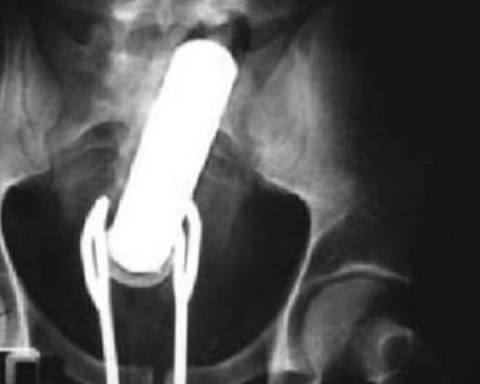De Darwin Award is een jaarlijkse prijs die postuum wordt gegeven aan degene die het afgelopen jaar op de stomste manier om het leven is gekomen. De winnaar van 1995 was een man die om het leven kwam nadat een colamachine bovenop hem was gevallen. De man had geprobeerd een gratis blikje uit de machine te vissen.
De winnaar van 1996 is een man die waarschijnlijk een snelheidsrecord had willen vestigen met zijn auto; een huis- tuin- en keuken Chevrolet. De man had een vliegtuigmotor bovenop zijn auto had gemonteerd, een zogeheten JATO-Unit. Dit is een hulpmotor waarmee straaljagers sneller kunnen opstijgen. Belangrijk om te weten is dat deze JATO-units niet meer afgezet kunnen worden als ze eenmaal zijn aangezet. Ze geven een piloot gedurende 20 seconden extra vermogen. Hierna is de brandstof op.
Amerikaanse onderzoekers zijn maanden bezig geweest om te onderzoeken wat zich precies op een verlaten snelweg in Arizona moet hebben afgespeeld. Zij kwamen met de volgende reconstructie:
De chauffeur van de Chevrolet heeft de ontsteking van zijn JATO-vliegtuigmotor ongeveer vijf kilometer voor de crash aangezet. De JATO heeft waarschijnlijk binnen vijf seconden de maximumsnelheid bereikt, waardoor de auto met meer dan 500 kilometer per uur werd voortgestuwd.
De auto bleef ongeveer drie kilometer (15 seconden) op het rechte stuk snelweg. Toen probeerde de chauffeur af te remmen. Hierdoor smolten de remmen en klapten de banden. Dikke rubbersporen op de weg ondersteunen deze theorie. Hierna vloog de auto enige tientallen meters de lucht in. Twee kilometer verder boorde de auto zich op een hoogte van veertig meter in een rots.
Het grootste deel van de overblijfselen van de man werden nooit teruggevonden. Alleen een vingernagel en enkele kleine botstukjes werden uit een stuk van het stuur gepeuterd.
Waar of niet waar?
Niet waar. Dit verhaal is overigens een van de eerste broodje-aapverhalen die vooral via het Internet verder verspreid werden.
In Wired heeft ooit een mooi artikel gestaan over het verhaal:
Heard the One About the Rocket Car?
Hasn’t everyone? Now meet the guy who says he lit the fuse.
Editor’s note: Wired found the following tale posted on the Web, originally at a site called cardhouse.com. According to its author, the story has garnered thousands of emails, some filled with praise, others with doubt, delight, sympathy, or suspicion. After a series of cagey communications with the writer, we reprint the piece here in the spirit of “all of the above.”
Fast Foreword
The first thing you should know about the Legend of the Rocket Car is that it’s been around longer than most people think. It started years ago, as a vague rumor passed from one guy to the next by word of mouth, usually in bars or during lunch-break bullshit sessions. The kind of story someone hears from a friend who read it in a magazine a long time ago. It’s a story that comes out of nowhere, gets passed around for a while, then dies out. And whenever it flickers back to life, it seems to spread like a grass fire. I used to think it was funny how it managed to spread so fast purely by word of mouth, but now that it’s become a subject of Internet interest, its popularity is downright spooky.
If you’ve never heard the legend before, here are the bare bones of it: Once upon a time, in some out-of-the-way part of the country (take your pick of locations), a maniac took a rocket of some sort and mounted it on the back of a car (make and model depend on the automotive trends when the story is told). The maniac then sped down a deserted stretch of highway, and when he reached an appropriate spot, lit the rocket (which was either a JATO bottle, a surplus ICBM engine, or an experimental shuttle booster). The car reached an incredible speed in a matter of seconds (somewhere between 150 miles per hour and warp 9) at which point the brakes and steering became … ineffective. This development would’ve been bad enough on a straightaway, but through some error in planning or navigation, the maniac found himself hurtling toward a sharp curve. When the car hit the curve, pilot and car flew like an arrow (for a distance limited only by the imagination of the person telling the story), before crashing into an inconveniently placed mountainside.
Nifty.
I don’t have much interest in urban legends. I only pay attention to the rocket car story because I’m 99 percent sure I started the whole thing.
I’m sure this sounds pretty ridiculous if it’s the first time you’ve heard the Legend of the Rocket Car, but that’s because I didn’t go out of my way to make it sound good. Most people try to make the story convincing, embellishing it with all sorts of facts and details to make it easier to swallow. I’ve personally heard a dozen versions over the past 20 years, and I’m amazed at how the story grows, shrinks, and generally mutates with each retelling.
I’m sure I notice these changes more than most people. I’m not a car expert or an aerospace engineer or anything, and I really don’t have much interest in urban legends. Even if I did, from an intellectual point of view, this story isn’t as entertaining as some of the others that have come and gone. The one about McDonald’s shoveling worms into the grinders that produce Big Macs, for instance, beats it by a mile. I only pay attention to the rocket car legend because I’m 99 percent sure that I started the whole thing in the spring of 1978.
Now, before you draw any conclusions, I don’t want you to get the impression that I, myself, claim to be the maniac who drove the rocket car into the wild blue yonder. I’m saying I was probably responsible for the rumor, not that I actually performed the test flight. As far as I know, the flight in question never happened. Like all legends, some basics of the story are true, but once the tale started circulating, the truth was lost in the embellishments. If the Legend of the Rocket Car survives, my great-grandchildren will probably end up talking about a guy from Lunartown who nailed an antimatter pod onto an old Apollo moonrover and flew into the side of Tycho Crater.
That’s how it goes with legends.
But like I said, I’m not a rocket scientist or a motorhead. I’m a high school biology teacher. And the fact that I’m a biology teacher is relevant to the extent that it’s responsible for my writing this story down.
Two years ago, a week or so before Thanksgiving, I was taking my class through some of the particulars of evolution (“How human beings were raised from monkeys,” as one of my students phrased it). We were discussing Charles Darwin and The Origin of Species when one of my students asked me how Darwin’s research ship ever got the name HMS Beagle.
Since I’ve been teaching this subject for 11 years, it’s rare when a student asks a question I can’t answer. But this one was a real pisser. Anyone who’s ever taught in a classroom knows that sometimes you get a student who likes to play Stump the Teacher – a kid who asks questions he doesn’t really care about, just to see if he can find a gap in the teacher’s knowledge. Usually these questions are pretty easy to evade or ignore, but sometimes one will catch my interest. This was one of the latter. So I told the student I had no idea where the ship’s name came from, but I’d find out.
Ha. I couldn’t find the answer anywhere. My reference books concerned themselves with headier subjects – the Scopes trial, genetic mutations – than the name of Darwin’s boat. I looked through every book I could find, but came up dry. After exhausting all my research options, I was thinking about conceding this particular round of Stump the Teacher when one of my kids asked if I’d looked for the information on the World Wide Web.









